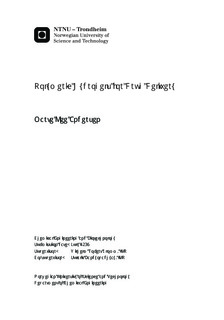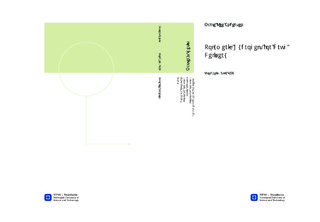| dc.description.abstract | Targeting specific drugs to a diseased site is widely studied both in vitro and in vivo, but very few systems have made entry into the clinical market. The systems today cause unwanted side effects due to the lack of specific targeting. This means that a larger dose is required to treat the disease. An interesting option to study within drug delivery systems is the synthesis and proper optimization of Poly(N-Isopropylacrylamide) (PNIPAm), a thermo-responsive polymer. This polymer can be cross-linked with Acrylic Acid (AAc) to form nanogels, which are in the form as hydrogels. PNIPAm/AAc can undergo a volume phase transition at and above its specific volume phase transition temperature (VPTT). This can trigger release of drugs at targeted sites in vivo.
The work described in this thesis focused on studying the loading and release of the PNIPAm/AAc nanogels. The loading has been assumed to occur in the hydrophilic state of the polymer, when the network can contain high ratio of water. In this state the hydroxyl groups of AAc are de protonated and Coulombic repulsive forces dominate. The drug solution has been introduced to freeze-dried nanogels when they were in the solid state. In this state the polymers can be compared to a sponge which absorbs the solution. This loading mechanism is known as the breathing in mechanism. This mechanism has been used to load two biologically relevant drugs; paracetamol (commonly used experimental drug in the laboratory) and Cytochrome C (a hydrophilic protein which is biologically relevant and whose properties are dependent on pH).
The nanogels have been synthesized, freeze-dried and suspended in solution (1 mg/mL). The properties of these freeze-dried nanogels have been mapped using dynamic light scattering (DLS). The nanogel swelling/de-swelling kinetics have been confirmed to be reversible and the VPTT has been measured at 36 °C (synthesized with 3 mM sodium dodecyl sulphate (SDS) and 8 % N, N Methylenebis(acrylamide) (BIS)) and 39 °C (synthesized with 4 mM SDS and 5 % BIS) respectively.
The loading studies with paracetamol indicated that the drug is relatively hydrophobic. This drug has shown to have higher loading - (61 %) and encapsulation efficiencies (16 mg drug/mg polymer) at elevated temperature, when the nanogel was de-swollen and was in the hydrophobic state. This implied that the nanogel made hydrophobic interactions with the drug. Raising the temperature higher has shown to give squeezing release. The release has also been observed when lowering the temperature below VPTT (when the drug was swollen and hydrophilic). The loading and release studies of paracetamol have also been performed by changing the pH. At pH 3 the hydroxyl groups of AAc is highly protonated (pKa = 4.25), which gave polymer/paracetamol interactions and thereby relatively high loading - (60 %) and encapsulation efficiencies (14 mg drug/mg polymer). An increase of the pH to 7 has also given efficient release (46 %) due to the de protonation of the hydroxyl groups.
In contrast to the measurements of the free (i.e.; not bound) paracetamol for the calculations of loading and release; the bound Cytochrome C was measured after dialysis. Through this method the free Cytochrome C was shown to diffuse through the dialysis membrane, while successful loading and release were proven by measurements of the bound protein. Cytochrome C loading and encapsulation efficiencies have been calculated to be 86 % and 0.17 mg drug/mg polymer respectively. Release studies of the protein have been performed at 39 °C, and with three different surrounding pHs: At normal pH conditions, at lowered pH (pH 3) and in PBS solution. The fastest and most efficient release has been observed with lowered pH (24 % release after 24 h).
The nanogels have shown successful loading and release of both hydrophobic and hydrophilic drug molecules by triggering release with change in temperature and pH. This makes them very interesting as drug carriers. The nanogels have the ability to target the desired site with proper modifications, and to exhibit controllable release. This along with stability and degradability of the nanogels can be achieved by modification of the surface. Modification with Poly(Ethylene glycol) (PEG) will avoid early renal clearance of the nanogels. The nanogels can also be incorporated to metal nanoparticles (NPs) which will make it possible to use an electromagnetic field to trigger the release of incorporated drug (in addition to enabled detection and imaging). | |

